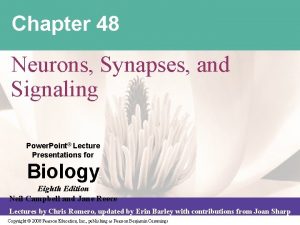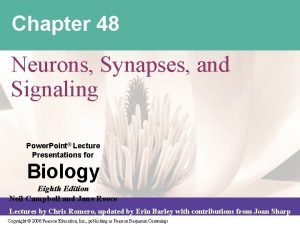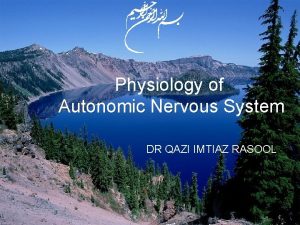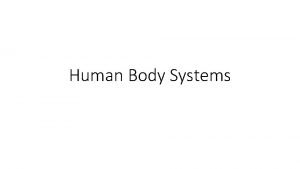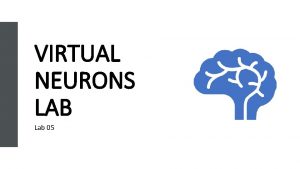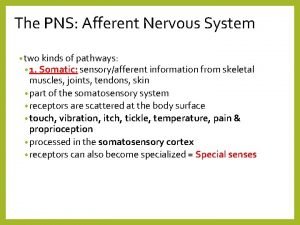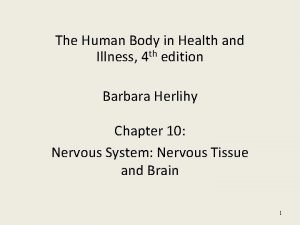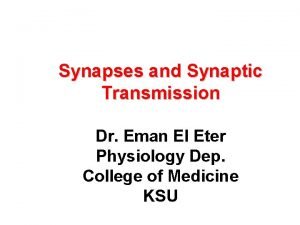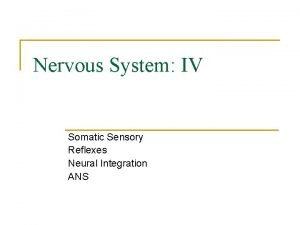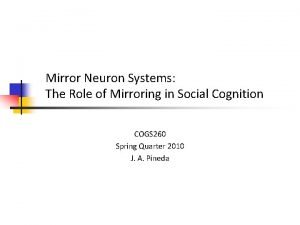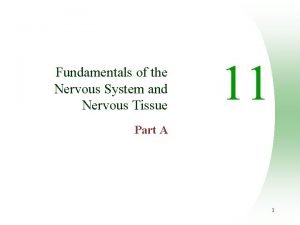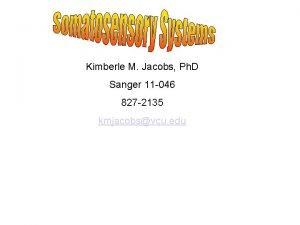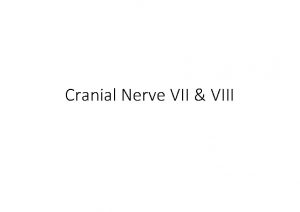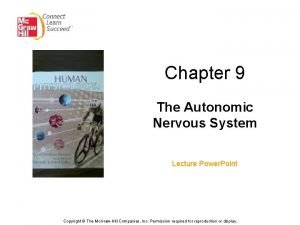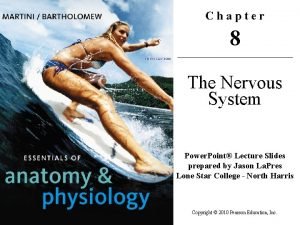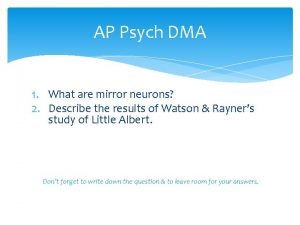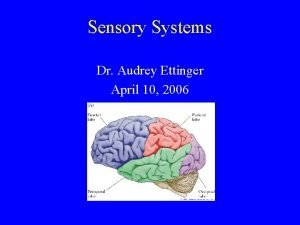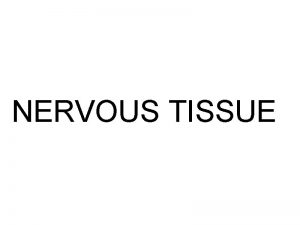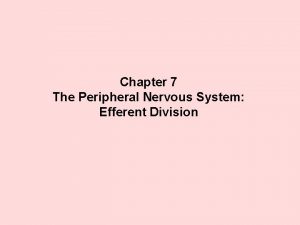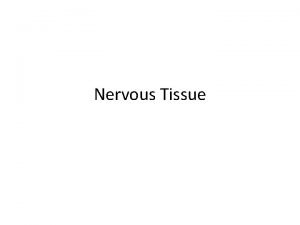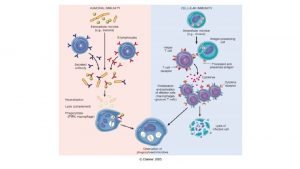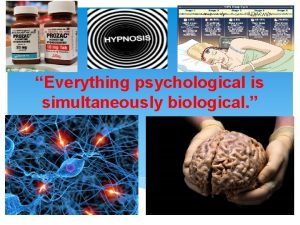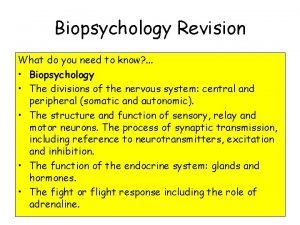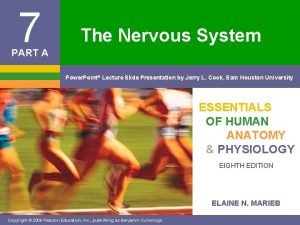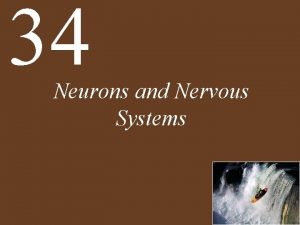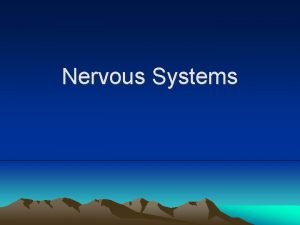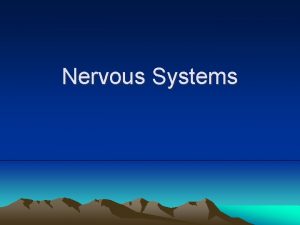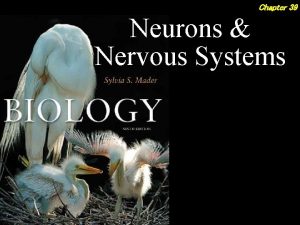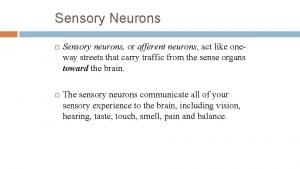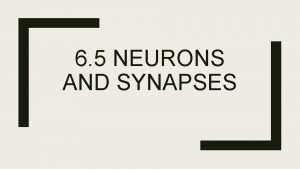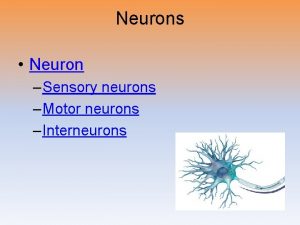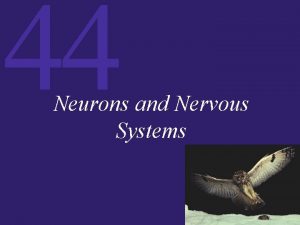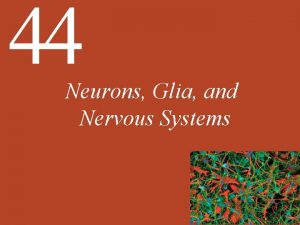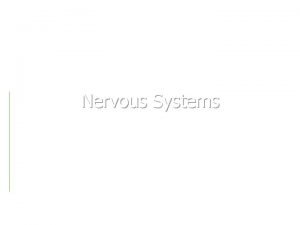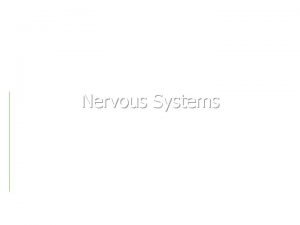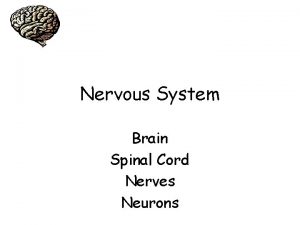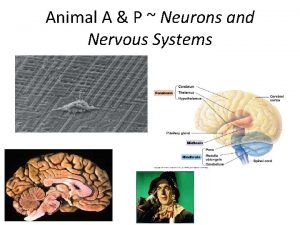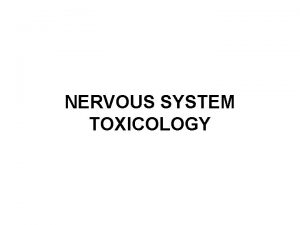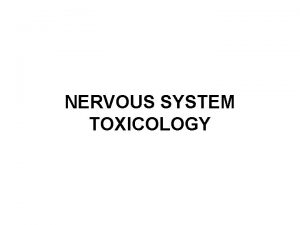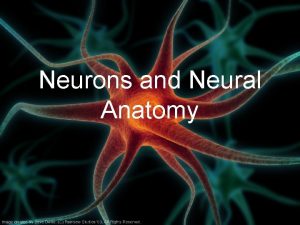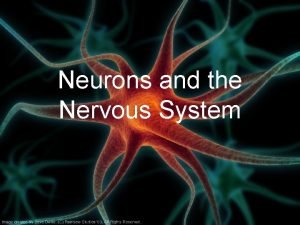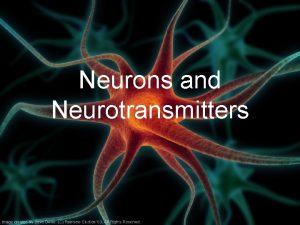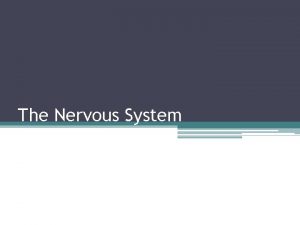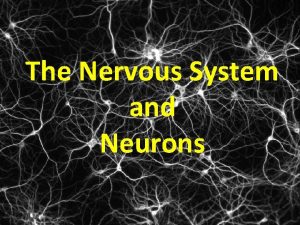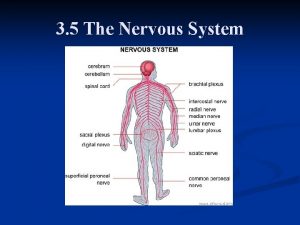Chapter 39 Neurons Nervous Systems 2 Outline EVOLUTION







































- Slides: 39

Chapter 39 Neurons & Nervous Systems

2 Outline EVOLUTION OF THE NERVOUS SYSTEM Gradual increase in the complexity of the nervous system All vertebrates have a well-developed brain NERVOUS TISSUE Neurons Nerve impulse BRAIN AND SPINAL CORD Spinal cord Cerebrum Sensory input Motor control Homeostasis Limbic system PERIPHERAL NERVOUS SYSTEM Nerves Somatic system Autonomic system

3 Invertebrate Nervous Organization Hydras Nerve net composed of neurons in contact with one another Also in contact with contractile epitheliomuscular cells Planarians Ladderlike nervous system Cephalization - a concentration of ganglia and sensory receptors in the head Annelids, Arthropods and Molluscs Complex animals True nervous systems

Evolution of the Nervous System 4

5 Vertebrate Nervous Organization Central nervous system Develops from an embryonic dorsal tubular nerve cord Cephalization and bilateral symmetry result in several paired sensory receptors Vertebrate brain is organized into three areas Hindbrain Midbrain Forebrain

6 Human Nervous System Nervous system has three specific functions Receiving sensory input Performing integration Generating motor output

Organization of the Human Nervous System 7

8 Human Nervous System Central nervous system (CNS) Includes the brain and spinal cord Lies in the midline of the body The peripheral nervous system (PNS) Contains cranial nerves and spinal nerves that Gather info from sensors and conduct decisions to effectors Lies outside the CNS

9 Nervous Tissue Neurons Cell body contains nucleus Dendrites receive signals from sensory receptors Axon conducts nerve impulses Covered by myelin sheath Any long axon is also called a nerve fiber

10 Types of Neurons Motor Neurons Accept nerve impulses from the CNS Transmit them to muscles or glands Sensory Neurons Accept impulses from sensory receptors Transmit them to the CNS Interneurons Convey nerve impulses between various parts of the CNS

Neuron Anatomy 11

Nerve Impulses: Resting Potential 12 Resting Potential The membrane potential (voltage) when the axon is not conducting an impulse The inside of a neuron is more negative than the outside -65 m. V Due in part to the action of the sodium-potassium pump

13 Action Potential An action potential is generated only after a stimulus larger than the threshold Gated channel proteins Suddenly allows sodium to pass through the membrane Another allows potassium to pass through other direction

Resting and Action Potential of the Axonal Membrane 14

15 Propagation of Action Potentials In myelinated fibers, an action potential at one node causes an action potential at the next node Saltatory (jumping) Conduction of a nerve impulse is an all-or-nothing event Intensity of signal is determined by how many impulses are generated within a given time span

16 Transmission Across a Synapse A synapse is a region where neurons nearly touch Small gap between neurons is the synaptic cleft Transmission across a synapse is carried out by neurotransmitters Sudden rise in calcium at end of one neuron Stimulates synaptic vesicles to merge with the presynaptic membrane Neurotransmitter molecules are released into the synaptic cleft

Synapse Structure and Function 17

18 Synaptic Integration A single neuron is on the receiving end of Many excitatory signals, and Many inhibitory signals Integration The summing of signals from Excitatory signals, and Inhibitory signals

Synapse Integration 19

20 CNS: Brain and Spinal Cord Spinal cord and brain are wrapped in three protective membranes, meninges Spaces between meninges are filled with cerebrospinal fluid Fluid is continuous with that of central canal of spinal cord and the ventricles of the brain

21 Spinal Cord The spinal cord has two main functions Center for many reflex actions Means of communication between the brain and spinal nerves The spinal cord is composed of gray matter and white matter Cell bodies and short unmyelinated fibers give the gray matter its color Myelinated long fibers of interneurons running in tracts give white matter its color

22 The Brain Cerebrum is the largest portion of the brain in humans Communicates with, and coordinates the activities of, the other parts of the brain Longitudinal fissure divides into left and right cerebral hemispheres

The Human Brain 23

24 Cerebral Cortex A thin but highly convoluted outer layer of gray matter Covers the cerebral hemispheres Contains motor areas and sensory areas as well as association areas Primary motor area is in the frontal lobe just ventral to central sulcus Primary somatosensory area is just dorsal to central sulcus

The Lobes of a Cerebral Hemisphere 25

26 Cerebrum Rest of cerebrum is composed of white matter Descending tracts communicate with lower brain centers Ascending tracts send sensory information to primary somatosensory area Basal nuclei Integrate motor commands Ensure that the proper muscle groups are either activated or inhibited

27 Diencephalon A region encircling the third ventricle Consists of hypothalamus and thalamus Hypothalamus forms floor of the third ventricle Thalamus consists of two masses of gray matter located in the sides and roof of the third ventricle Pineal gland Also located in the diencephalon Secretes melatonin

28 Cerebellum Separated from the brain stem by the fourth ventricle Receives sensory input from the eyes, ears, joints, and muscles Sends motor impulses out the brain stem to the skeletal muscles

29 Brain Stem Contains the midbrain, the pons, and the medulla oblangata Midbrain Acts as a relay station for tracts passing between w The cerebrum, and w The spinal cord or cerebellum Pons Helps regulate breathing and head movements Medulla oblongata Contains reflex centers for vomiting, coughing, sneezing, hiccuping, and swallowing

30 Limbic System Complex network of tracts and “nuclei” Incorporates medial portions of The cerebral lobes, The subcortical basal nuclei, and The dicenephalon Integrates higher mental functions and primitive emotions Hippocampus Amygdala

The Limbic System 31

32 Peripheral Nervous System Somatic system Contains cranial nerves and spinal nerves Gather info from sensors and conduct decisions to effectors Controls the skeletal muscles Conscious of its activity Autonomic system Controls the smooth muscles, cardiac muscles, and glands Usually unaware of its actions Divided into two divisions Sympathetic division Parasympathetic division

Cranial and Spinal Nerves 33

A Reflex Arc Showing the Path of a Spinal Reflex 34

35 Autonomic System Regulates activity of cardiac and smooth muscle, and glands Divided into sympathetic and parasympathetic divisions Function automatically and usually in an involuntary manner Innervate all internal organs Utilize two neurons and one ganglion for each impulse

Autonomic System Structure and Function 36

Sympathetic and Parasympathetic Divisions 37 Sympathetic division Especially important during fight or flight responses Accelerates heartbeat and dilates bronchi Parasympathetic division Promotes all internal responses associated with a relaxed state Promotes digestion and retards heartbeat

38 Review EVOLUTION OF THE NERVOUS SYSTEM Gradual increase in the complexity of the nervous system All vertebrates have a well-developed brain NERVOUS TISSUE Neurons Nerve impulse BRAIN AND SPINAL CORD Spinal cord Cerebrum Sensory input Motor control Homeostasis Limbic system PERIPHERAL NERVOUS SYSTEM Nerves Somatic system Autonomic system

Ending Slide Chapter 39 Neurons & Nervous Systems
 Label the different types of neuronal pools in the figure.
Label the different types of neuronal pools in the figure. Fundamentals of the nervous system and nervous tissue
Fundamentals of the nervous system and nervous tissue Processes neuron
Processes neuron Chapter 14 skeletal muscular and nervous systems
Chapter 14 skeletal muscular and nervous systems Chapter 48 neurons synapses and signaling
Chapter 48 neurons synapses and signaling Chapter 48 neurons synapses and signaling
Chapter 48 neurons synapses and signaling Module 10 the nervous and endocrine systems
Module 10 the nervous and endocrine systems Sympathetic nervous systems
Sympathetic nervous systems 副交感神経
副交感神経 Nervous interactions with other systems
Nervous interactions with other systems Sandwich in a sentence
Sandwich in a sentence Virtual neurons
Virtual neurons Neuron order
Neuron order Homunculus
Homunculus 1st order 2nd order 3rd order neurons
1st order 2nd order 3rd order neurons Synapse ppt
Synapse ppt Input neurons
Input neurons Somatic motor association area
Somatic motor association area Stretch reflex
Stretch reflex Location of sensory neurons
Location of sensory neurons Mirror neuron
Mirror neuron Input neurons
Input neurons Neuronal pools
Neuronal pools Pyramid of medulla
Pyramid of medulla Fourth order neurons
Fourth order neurons Vestibulocochlear nerve.
Vestibulocochlear nerve. Preganglionic and postganglionic parasympathetic neurons
Preganglionic and postganglionic parasympathetic neurons Figure 8-2 neurons and neuroglia
Figure 8-2 neurons and neuroglia Mirror neurons ap psych
Mirror neurons ap psych Characteristics of sensory neurons
Characteristics of sensory neurons What are neurons composed of
What are neurons composed of Neuroglial cell
Neuroglial cell Efferent motor neurons
Efferent motor neurons Nervous tissue
Nervous tissue Myelinzation
Myelinzation Everything psychological is simultaneously biological
Everything psychological is simultaneously biological Sensory vs somatic
Sensory vs somatic Biopsychology revision
Biopsychology revision Secondary reinforcer ap psychology definition
Secondary reinforcer ap psychology definition Unipolar neurons are found in
Unipolar neurons are found in




